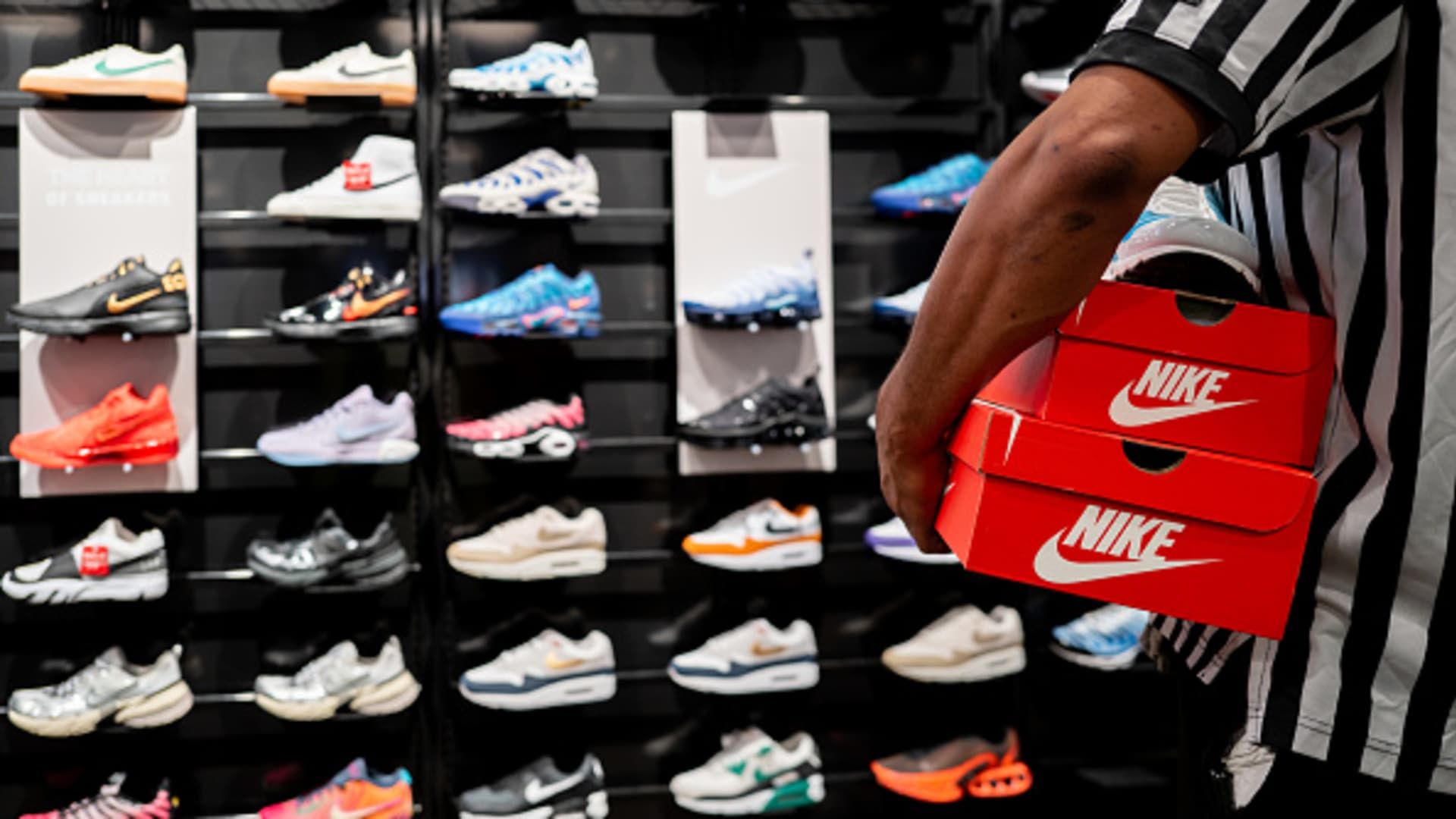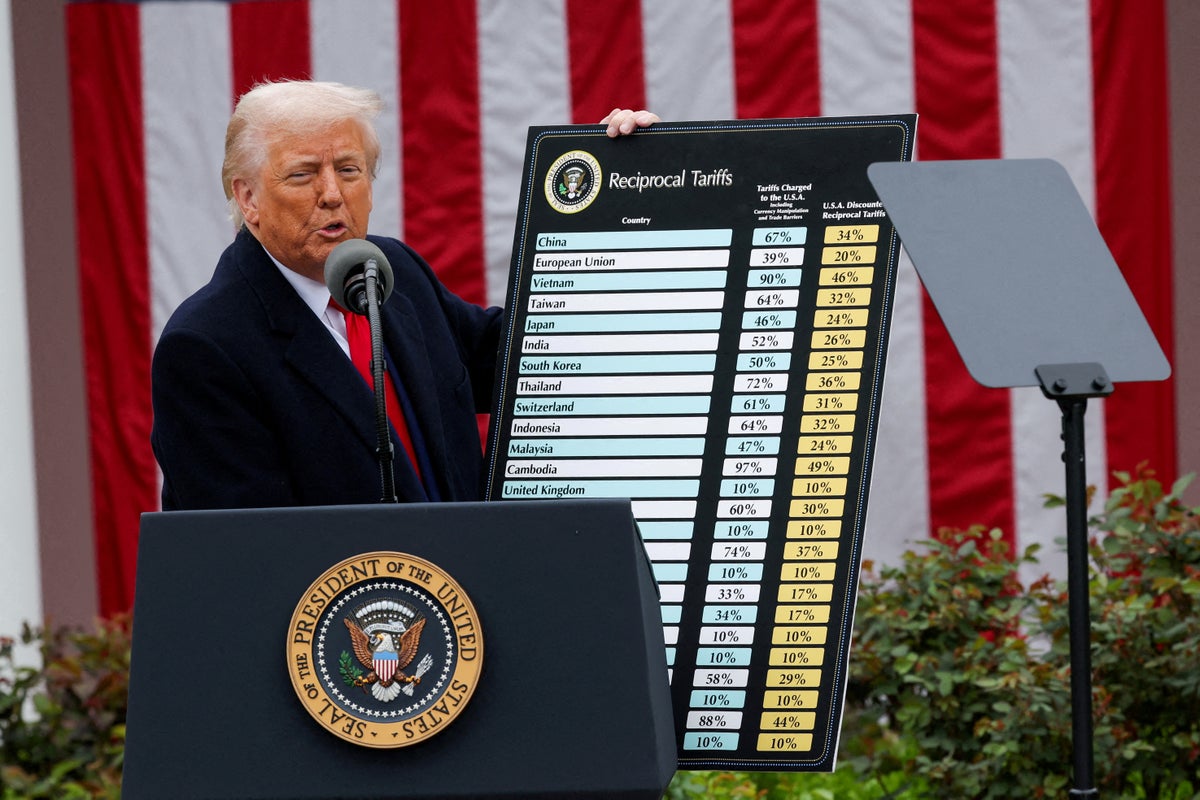An employee carries boxes of shoes at the Footlocker retail store at the Barton Creek Square shopping center on August 28, 2024 in Austin, Texas.
Brandon Bell | fake images
Nike on Tuesday it said it would withdraw its full-year guidance and postpone its investor day as it prepares for a new chief executive to take the helm.
Last month, the company announced that CEO John Donahoe would resign in October and be replaced by veteran Elliott Hill, effective October 14. Given the impending CEO change, the company has decided to withdraw its full-year guidance and intends to provide quarterly guidance for the remainder of the year, executives said.
“This provides Elliot the flexibility to reconnect with our employees and teams, assess current strategies and business trends and develop our plans to best position the business for FY26 and beyond,” said CFO Matthew Friend on an earnings call with analysts. .
Reporting fiscal fourth-quarter results in June, Nike cut its fiscal 2025 guidance and said it expected sales to decline by mid-single digits after previously expecting them to grow. Friend said that since the fiscal year began, the company's “revenue expectations have been tempered… given traffic trends on Nike Digital, market-wide retail sales trends and final order books for spring.”
“We continue to see signs of a slight improvement in revenue trends in the second half compared to the first half,” Friend said. “As we plan to introduce and expand new developments and innovation throughout the market, we now expect gross margins to decline compared to the prior year.”
Nike said it expects revenue in its current quarter to be down 8% to 10% and gross margin to be down about 1.5 percentage points. That's worse than the 6.9% drop in revenue that LSEG analysts were expecting.
It will also postpone its investor day, initially scheduled for November. It is unclear when the meeting will be rescheduled.
Shares fell about 5% in extended trading after the updates and after Nike reported mixed results for its fiscal first quarter.
Here's how the world's largest sneaker retailer performed compared to what Wall Street anticipated, according to a survey of analysts by LSEG:
- Earnings per share: 70 cents vs. 52 cents
- Revenue: $11.59 billion vs. $11.65 billion
The company's reported net income for the three months ended Aug. 31 was $1.05 billion, or 70 cents per share, compared with $1.45 billion, or 94 cents per share, a year earlier.
Nike beat earnings expectations by 18 cents but fell short on revenue as it works to fix its product assortment and rework its approach to innovation.
Sales fell to $11.59 billion, down about 10% from $12.94 billion a year earlier.
Nike's gross margin grew 1.2 percentage points in the quarter to 45.4%, higher than the 44.4% StreetAccount analysts expected. Still, profits fell nearly 28% during the quarter.
Innovation
Over the past year, Nike has been accused of falling behind in innovation and ceding share to competitors as it focused on selling directly to consumers through its own websites and stores rather than through wholesalers such as standing locker and DSW.
At first, the strategy was a boon to Nike's profits and sales during the Covid pandemic, but as it grew, it became more complex and consumers began returning to stores and other in-person activities.
During the quarter, Nike's direct sales decreased 13% to $4.7 billion, while Nike's digital sales decreased 15%.
Critics say Nike's focus on direct sales also led it to stop paying attention to innovation.
Under Donahoe's leadership, the company increased its annual sales by more than 31%, but it did so by producing legacy franchises like the Air Force 1, Dunks and Air Jordan 1, not the innovative styles that made the company a global powerhouse.
Sales from those legacy franchises are no longer driving sales the same way they once were, and as a result, the company has worked to cut supply to increase demand and regain its cool factor.
During the first quarter, sales of those franchises declined more than the overall business. Online sales of Air Force 1, Dunks and Air Jordan 1 combined fell by almost 50%. Only Jordan Brand was down double digits during the quarter, and the company expects it to decline at the same rate by fiscal 2025.
The company also expects overall online sales to decline by double digits in fiscal 2025.
Wholesale
Last year, Donahoe began to recognize that Nike needed to improve its relationships with wholesalers, but the company's board of directors decided that Hill, who spent 32 years at Nike before retiring in 2020, would be the right person to lead its next chapter. .
Hill is known to be well-regarded among Nike's retail partners; When he takes office later this month, he will have work to do to rebuild those relationships.
Wholesalers have previously talked about Nike's product line and how the same old recycling franchises weren't doing enough to boost sales. They have also been working to keep their own inventories in order and have been careful not to order too much product.
Nike's fiscal first-quarter wholesale revenue fell 8% to $6.4 billion.
“The multi-brand environment is very competitive today and it will take time to expand market share. This was reflected in our spring 2025 order books, which remained virtually unchanged compared to the previous year,” Friend said at the results conference call. The addition of orders was “a little lighter” than expected.
Compounding the problem is the overall sneaker market, which has been relatively stagnant in the United States, and a slowdown in consumer spending on discretionary goods like new clothes and shoes.
U.S. footwear sales are expected to grow just 2% in 2024 compared to 2023, after barely changing between 2022 and 2023, according to Euromonitor. Athletic footwear is expected to grow approximately 5.6%, the company said.
During the most recent quarter, Nike footwear sales in North America fell 14% and apparel sales fell 10%.
Converse, which Nike acquired in 2003, is also weighing on the company's overall performance. Sales fell 15% to $501 million during the quarter, but performed better than the $493 million analysts expected, according to StreetAccount.
Porcelain
Nike's performance has also been hurt by the uneven economy in China, Nike's third-largest market by revenue. Nike's performance in China is often an indicator of the region's financial health, and in late June it warned of a “softer outlook” in the region.
During its fiscal first quarter, Nike posted $1.67 billion in revenue in the region, slightly above the $1.62 billion analysts were expecting, according to StreetAccount. Still, traffic was “soft” in the region and Friend said Nike is “not immune” to China's challenging consumer environment.
China's central bank recently unveiled its biggest stimulus measures since the Covid pandemic, which are expected to give the region's economy a much-needed boost.
Nike's fiscal first quarter concluded before those stimulus measures, but executives can share details about how sales are performing during the current period.
Nike shares closed at $89.13 on Tuesday, down about 18% so far in 2024, significantly underperforming the S&P 500's gains of about 20%.










